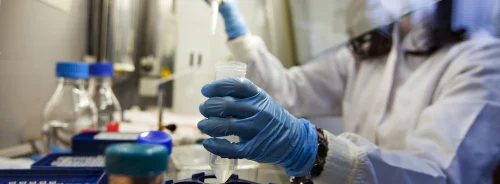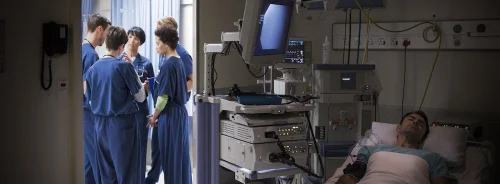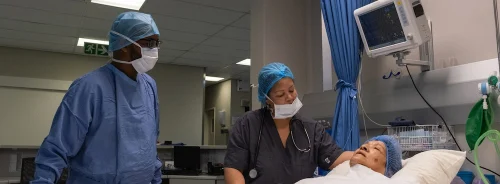ICU Management & Practice, Volume 22 - Issue 4, 2022
Introduction
Antimicrobial resistance (AMR) is an imminent threat to global health and has been accelerated by the inappropriate use of antimicrobials (Llor and Bjerrum 2014). Antimicrobial stewardship (AMS) is crucial to optimise patient outcomes and minimise drug toxicity and emergence of resistance (Patel and Fang 2018). Diagnostic stewardship (DS) is an essential component of AMS that entails ordering the right tests for the right patient at the right time. It also promotes the use of rapid and novel molecular diagnostic tools to allow for initiation of proper antibiotic therapy while avoiding excessive use of broad-spectrum antibiotics when not needed. Care should be taken in the interpretation of the test results to avoid overdiagnosis, and unnecessary costs (Patel and Fang 2018). Despite promising results, rapid diagnostics are limited by cost, accessibility, and misinterpretation. DS relies on thorough history taking and physical examination, targeted diagnostics, appropriate specimen collection, and proper interpretation of results. Additionally, multidisciplinary teams with highly trained professionals should be involved in the diagnostic pathway. We herein discuss how DS can be implemented in five common infectious syndromes frequently encountered in the intensive care units (ICU).
1. Hospital-Acquired and Ventilator-Associated Pneumonia
Ventilator-Associated Pneumonia (VAP) is a leading cause of death in the ICU (Torres et al. 2017; Melsen et al. 2013). However, it may be hard to differentiate colonisation from infection. In addition, given the accessibility of respiratory sampling in intubated patients, clinicians tend to request many respiratory cultures and risk misinterpreting them as infections (Kenaa et al. 2022; Nussenblatt et al. 2014; Morgan et al. 2017). In fact, up to 50% of patients treated with antibiotics for VAP in the ICU may just be colonised (Swoboda et al. 2006). On the other hand, a delay in initiating antibiotic therapy for VAP is correlated with greater mortality (Fowler et al. 2003). Recent studies suggest that microbiological identification prior to treatment initiation is desirable in patients who are not septic and may reduce emergence of resistance (Le Terrier et al. 2021). The Infectious Diseases Society of America (IDSA) recommends the use of both clinical and microbiological criteria to diagnose VAP, with re-evaluation occurring no later than 48 hours after starting antimicrobials (IDSA 2005).
Long turnaround times of conventional methods may delay targeted antimicrobial therapy. In a retrospective study conducted in an ICU in France during the COVID-19 pandemic, a rapid microbiological diagnostic test based on the Nested Multiplex Polymerase Chain Reaction (mPCR) method was used on protected telescopic catheter (PTC) specimens. This semi-quantitative test allows detection of 15 bacteria, 3 atypical bacteria, 9 viruses, and 7 antibiotic resistance genes within 1.5 hours of sample collection. This study showed that mPCR performed well on PTC samples with a sensitivity of 93%, a specificity of 99%, and a negative predictive value (NPV) of 100% (Razazi et al. 2022). In another retrospective multicentre study, respiratory samples were simultaneously tested using conventional microbiological methods and the new syndromic rapid multiplex PCR test (rm-PCR). The syndromic rm-PCR detected 83% of episodes of infections compared to 60% in conventional cultures and allowed treatment escalation/de-escalation in 77% of pneumonia cases (Monard et al. 2020). In another study, a multidisciplinary expert panel analysed 95 samples and simulated the changes they would have made had the mPCR been available. It concluded that mPCR improved empirical therapy, reduced the use of broad-spectrum antimicrobials, and even diagnosed two cases of unexpected severe legionellosis (Peiffer-Smadja et al.2020).
The INHALE WP1 study is a multicentre study evaluating two mPCR platforms for rapid microbiological screening of critically ill patients with Hospital-Acquired Pneumonia (HAP) in 15 ICUs in the U.K. Both systems were significantly faster and detected more pathogens than regular microbiology tests. Importantly, PCR detects additional organisms and could improve microbiological diagnosis of pneumonia. Bayesian latent class analysis (BLC) showed low sensitivity for routine microbiological analysis, and a higher specificity and PPV of the PCR tests when compared to routine microbiological analysis (Enne et al. 2022). Moreover, although PCR did not provide a complete susceptibility profile, it was a rapid and sensitive predictor of critical resistance that had infection control implications (Enne et al. 2022). Currently, a randomised controlled trial is exploring the potential benefits of mPCR in guiding treatment of HAP/VAP in ICU patients (High et al. 2021).
2. Central Nervous System Infections
Central nervous system (CNS) infections are associated with a very high mortality rate (Giovane and Lavender 2018). Clinical presentation cannot often differentiate a bacterial from a viral cause. It is recommended to initiate empiric treatment if microbiological identification is delayed (van de Beek et al. 2016). Additionally, clinical assessment may be inconclusive in critically ill patients (Greenberg 2008). Thus, the use of rapid and precise diagnostic tools may reduce the time to initiate appropriate treatment and avoid unnecessary antimicrobials. Microarray PCR testing of cerebrospinal fluid (CSF) is a promising diagnostic tool. Not only it is capable of detecting organisms that are present in small loads, but it also has an accuracy of 90% and a short turnaround time of one hour (Tansarli and Chapin 2020). Microarray testing of CSF is particularly useful in paediatric patients where CNS infections can occur in the setting of normal CSF findings (Acuña et al. 2022). Nonetheless, such highly sensitive diagnostic tools may result in overdiagnosis especially if the pre-test probability is low (Moffa et al. 2020). In the absence of guidelines, DS interventions are essential to help clinicians with the proper use of advanced diagnostic tools to reduce overdiagnosis and unnecessary treatment (Goodlet et al. 2021).
Diagnostic algorithms orient clinicians
and are successful at reducing excessive
microarray PCR testing (Messacar et al.
2022). For instance, Broadhurst et al.
(2020) reported that diagnostic algorithms
avoided 75% of false-positive results without producing false-negatives. In many cases,
the absence of pleocytosis should discourage
clinicians from ordering molecular diagnostics. In fact, except in immunocompromised
patients and children less than 6 months of
age, CSF WBC has a high NPV of 98-100%
and rules out CNS infection (Broadhurst
et al. 2020). Commonly, management is
often influenced by physicians’ hesitancy
to undertreat, especially in the ICU. This is
evidenced by a study where 78% of patients
with suspected CNS infection and a negative
microarray result were maintained on
antimicrobials (Barry et al. 2021; Dack et al.
2019). Used wisely, high-yield diagnostic
tests significantly reduce time to adequate
treatment and duration of IV antimicrobial
therapy (Messacar et al. 2022).
3. Clostridioides difficile Infection
Clostridioides difficile infection (CDI) is very common among ICU patients receiving antimicrobial therapy (Dubberke and Wertheimer 2009). Nonetheless, up to 50% of patients with a positive nucleic acid amplification test (NAAT) are colonised rather than infected (Buckel et al. 2015; Polage et al. 2015). The adoption of highly sensitive NAAT instead of antigen or toxin-based assays increase the risk of over diagnosing CDI (Madden et al. 2018; Bartsch et al. 2015; Leffler and Lamont 2015; Crobach et al. 2016). Additionally, the absence of specific biologic markers for CDI further complicates the diagnosis (McDonald et al. 2018).
“Soft stops” that are integrated into
the electronic health system (EHS), such
as reminders to check for laxative use, can
facilitate decision making for clinicians
and improve test appropriateness (Quan
et al. 2018; White et al. 2017). Otherwise,
strict interventions called “hard stops”
where orders are blocked in the absence of
prespecified criteria may reduce excessive
testing by up to 56% (Quan et al. 2018;
Mizusawa et al. 2019; White et al. 2017).
Moreover, oral vancomycin prescriptions
were reduced in one study, after the implementation of a preauthorisation protocol
for CDI testing (Christensen et al. 2019).
When collecting samples, stool cultures
should be collected in a clean container,
kept at room temperature, and transported
within two hours. Besides, the microbiology laboratory plays an essential role
in promoting DS. For example, rejecting
non-loose stools has reduced testing by
43% and CDI events by 60% (Brecher
et al. 2013). Sample rejection according
to prespecified clinical criteria has also
helped reduce unnecessary CDI testing
without influencing mortality (Truong et
al. 2017). Although negative toxin testing
may predict a less severe course of illness,
clinicians should be aware that toxin-based
testing may not have enough NPV to rule
out CDI (Planche et al. 2013).
4. Bloodstream Infection
Excessive blood cultures (BC) orders are
common in ICU patients with vascular
and indwelling catheters who are at high
risk for bloodstream infections (BSI)
(Hugonnet et al. 2004). BC are often
driven by leucocytosis and fever despite
limited correlation (Fabre et al. 2020b).
In fact, a recent review reported that up to
20% of positive BC may be contaminated
(Doern et al. 2019). Contaminated BC increase antimicrobial exposure, costs, and
hospitalisation duration (Bates et al. 1990;
Doern et al. 2019). When BC are unlikely
to change the management in a patient
with a clear site of infection and without
sepsis or septic shock, they should not be
obtained (Fabre et al. 2020b). However, in
the presence of syndromes that are likely
to yield positive BC like CNS infections,
septic arthritis, and endovascular infections, or when sampling of the primary
site of infection is difficult, BC could be
of great value (Fabre et al. 2020b). The
DISTRIBUTE study aimed to optimise BC
practices by implementing an evidence-based algorithm for BC indications and
education and feedback to providers about
BC rates and appropriateness. It showed
that these interventions effectively and
safely reduce unnecessary BC (Fabre et al.
2020a). A machine learning model used
in a multicentre validation prospective
study showed that this model can safely
withhold BC analyses in at least 30% of
patients presenting to the ED (Schinkel
et al. 2022).
BC should be sampled before initiating antibiotics while adhering to strict hygiene measures (Rhodes et al. 2017; Murphy et al. 2014). DS bundles (including an informational video, a standard operating procedure, and ready-to-use paper crates with three culture sets) may also improve outcomes and optimise BC diagnostics (Walker et al. 2022).
Conventional BC have a long turnaround
time compared to novel diagnostics and
can lead to inappropriate antimicrobial use
(MacBrayne et al. 2021). Matrix-assisted
laser desorption/ionisation time-of-flight
mass systems (MALDI-TOF MS) is used for
rapid microbial identification, characterisation, and typing. However, it may better
detect gram-negative than gram-positive
bacteria. Routine application of this technique, which may also reduce the mortality
of bacteraemia, can further advance AMS
(Yuan et al. 2020). A randomised controlled
trial evaluating outcomes associated with
rm-PCR detection of bacteria, fungi, and
resistance genes directly from positive BC
found a reduction in the use of broad-spectrum antibiotics but without affecting
mortality, length of stay, or cost (Banerjee
et al. 2015). Another emerging diagnostic
tool is next generation sequencing (NGS),
an easy-to-use, culture-free, PCR-based
diagnostic method that seems to have
promising results (Sabat et al. 2017). Further
studies are needed to better understand
the cost effectiveness, impact on patient
outcome and role in the management of
novel diagnostic tools for BSIs.
5. Urinary Tract Infection
High pre-test probability of urinary tract infection (UTI) should be the main driver for requesting urine culture (UC) orders. However, UC are frequently ordered in the absence of symptoms, or when ambiguous symptoms are present, which may lead to overdiagnosis and inappropriate antibiotic initiation. Additionally, the yield of UC may be compromised by improper sampling, contamination, or misinterpretation. Clinicians should be aware that catheter-associated bacteriuria is common and often indicates colonisation rather than infection (Nicolle et al. 2005). Hence, the IDSA’s 2019 clinical practice guidelines strongly recommend against UC screening in patients with indwelling catheters (Nicolle et al. 2019) and only to obtain UC from febrile patients who are at high risk for invasive infections (renal transplant, recent genitourinary surgery, neutropenic patients, or evidence of obstruction).
To reduce unnecessary UC orders, numerous institutions have integrated computerised physician order entry and clinical decision support alerts in the electronic health systems (EHS) which are automatically generated whenever a urinalysis, UC, or antibiotics commonly prescribed for UTIs are ordered (Keller et al. 2018). These strategies are optimised when combined with educational support on AMS and infectious disease specialist guidance. For example, Shirley et al. (2017) reported 34% fewer UC orders for catheterised patients after including readily accessible guidelines in the EHS and requiring an indication when requesting a UC. Similarly, a neuro-ICU reported a significant reduction in catheter-associated UTI when nurses reviewed UC orders with critical care physicians for patients who did not meet predetermined criteria (Page et al. 2020).
Only allowing UC when urinalysis (UA) meets pre-specified criteria, called reflex UC, has been shown to significantly reduce unnecessary cultures. The presence of pyuria on UA is the most important trigger for reflex UC and has a NPV of more than 90% (Jones et al. 2014; Richards et al. 2019; Fok et al. 2010). Other used indicators can be positive leukocyte esterase, positive nitrite, or >5-10 WBC/HPF (Howard-Anderson et al. 2020). The presence of epithelial cells may indicate that the sample was incorrectly collected and contaminated with skin flora and must prompt physicians to reconsider proceeding with UC (Ling et al. 2020).
Systemic biomarkers such as CRP and
procalcitonin were shown to have poor or
limited role in DS strategies in UTIs (Covino
et al. 2020; Drozdov et al. 2015; Stalenhoef
et al. 2019). Other biomarkers such as
urinary myeloperoxidase, adenosine-5
-triphosphate and urinary xanthine oxidase
have too little sensitivity and specificity to
be recommended (Gill et al. 2015; Fritzenwanker et al. 2016). Novel diagnostic
tools such as flow cytometry (Fritzenwanker
et al. 2016), MALDI-TOF-MS and the
combination of both (Wang et al. 2013)
have also been attempted but are limited
by availability and costs.
Conclusion
Recent advances in AMS strategies aim to guide better patient care and enhance clinical outcomes while reducing unnecessary antimicrobial exposure. DS is essential for better implementation of stewardship activities. DS include diagnostic strategies for testing based on pre-set algorithms and including novel diagnostic tools in the work-up of patients. Despite some limitations and cost, these novel diagnostic technologies have been shown to contribute to the appropriate use of antimicrobials in various clinical syndromes. Unfortunately, novel molecular tests are not available in many middle and low-income countries. A global collaboration between all stakeholders including pharmaceutical companies, governmental, and societal organisations is essential to bring new technology to better use worldwide. In addition, in the hospital setting, a close collaboration between infectious disease specialists, critical care physicians and microbiologists is a must to optimise the care of ICU patients and provide evidence-based diagnostics and management.
Conflict of Interest
None
References:
Acuña M, Benadof D, Yohannessen K et al. (2022) FilmArray® Meningoencephalitis panel in the diagnosis of central nervous system infections: stewardship and cost analysis in a paediatric hospital in Chile. BMC Pediatrics. 22:182.
Banerjee R, Teng CB, Cunningham SA et al. (2015) Randomized Trial of Rapid Multiplex Polymerase Chain Reaction-Based Blood Culture Identification and Susceptibility Testing. Clin Infect Dis. 61:1071-80.
Barry R, Dempsey C, Barry L et al. (2021) On-site Multiplex PCR for CSF diagnostics in an Acute Hospital versus Referral to Reference Laboratories: Assessing Economic Factors, Length of Stay and Antimicrobial Stewardship. J Infect. 82:414-451.
Bartsch SM, Umscheid CA, Nachamkin I et al. (2015) Comparing the economic and health benefits of different approaches to diagnosing <em>Clostridium difficile</em> infection. Clinical Microbiology and Infection. 21:77.e1-77.e9.
Bates DW, Cook EF, Goldman L, Lee TH (1990) Predicting bacteremia in hospitalized patients. A prospectively validated model. Ann Intern Med. 113:495-500.
Brecher SM, Novak-Weekley SM, Nagy E (2013) Laboratory diagnosis of Clostridium difficile infections: there is light at the end of the colon. Clin Infect Dis. 57:1175-81.
Broadhurst MJ, Dujari S, Budvytiene I et al. (2020) Utilization, Yield, and Accuracy of the FilmArray Meningitis/Encephalitis Panel with Diagnostic Stewardship and Testing Algorithm. J Clin Microbiol. 58.
Buckel WR, Avdic E, Carroll KC et al. (2015) Gut check: Clostridium difficile testing and treatment in the molecular testing era. Infect Control Hosp Epidemiol. 36:217-21.
Christensen AB, Barr VO, Martin DW et al. (2019) Diagnostic stewardship of C. difficile testing: a quasi-experimental antimicrobial stewardship study. Infection control and hospital epidemiology. 40:269-275.
Covino M, Manno A, Merra G et al. (2020) Reduced utility of early procalcitonin and blood culture determination in patients with febrile urinary tract infections in the emergency department. Intern Emerg Med. 15:119-125.
Crobach MJ, Planche T, Eckert C et al. (2016) European Society of Clinical Microbiology and Infectious Diseases: update of the diagnostic guidance document for Clostridium difficile infection. Clin Microbiol Infect. 22(Suppl 4):S63-81.
Dack K, Pankow S, Ablah E et al. (2019) Contribution of the BioFire(®) FilmArray(®) Meningitis/Encephalitis Panel: Assessing Antimicrobial Duration and Length of Stay. Kans J Med. 12:1-3.
Doern GV, Carroll KC, Diekema DJ et al. (2019) Practical Guidance for Clinical Microbiology Laboratories: A Comprehensive Update on the Problem of Blood Culture Contamination and a Discussion of Methods for Addressing the Problem. Clin Microbiol Rev. 33.
Drozdov D, Schwarz S, Kutz A et al. (2015) Procalcitonin and pyuria-based algorithm reduces antibiotic use in urinary tract infections: a randomized controlled trial. BMC Medicine. 13:104.
Dubberke ER, Wertheimer AI (2009) Review of current literature on the economic burden of Clostridium difficile infection. Infect Control Hosp Epidemiol. 30:57-66.
Enne VI, Aydin A, Baldan R et al. (2022) Multicentre evaluation of two multiplex PCR platforms for the rapid microbiological investigation of nosocomial pneumonia in UK ICUs: the INHALE WP1 study. Thorax. thoraxjnl-2021-216990.
Fabre V, Klein E, Salinas AB et al. (2020a) A Diagnostic Stewardship Intervention To Improve Blood Culture Use among Adult Nonneutropenic Inpatients: the DISTRIBUTE Study. J Clin Microbiol. 58.
Fabre V, Sharara SL, Salinas AB et al. (2020b) Does This Patient Need Blood Cultures? A Scoping Review of Indications for Blood Cultures in Adult Nonneutropenic Inpatients. Clin Infect Dis. 71:1339-1347.
Fok C, Fitzgerald MP, Turk T et al. (2010) Reflex testing of male urine specimens misses few positive cultures may reduce unnecessary testing of normal specimens. Urology. 75:74-6.
Fowler RA, Flavin KE, Barr J et al. (2003) Variability in antibiotic prescribing patterns and outcomes in patients with clinically suspected ventilator-associated pneumonia. Chest. 123: 835-44.
Fritzenwanker M, Imirzalioglu C, Chakraborty T, Wagenlehner FM (2016) Modern diagnostic methods for urinary tract infections. Expert Rev Anti Infect Ther. 14:1047-1063.
Gill K, Horsley H, Kupelian AS et al. (2015) Urinary ATP as an indicator of infection and inflammation of the urinary tract in patients with lower urinary tract symptoms. BMC Urol. 15:7.
Giovane RA, Lavender PD (2018) Central Nervous System Infections. Prim Care. 45:505-518.
Goodlet KJ, Tan E, Knutson L, Nailor MD (2021) Impact of the FilmArray meningitis/encephalitis panel on antimicrobial duration among patients with suspected central nervous system infection. DiagnMicrobiol Infect Dis. 100:115394.
Greenberg BM (2008) Central nervous system infections in the intensive care unit. Semin Neurol. 28:682-9.
Guidelines for the management of adults with hospital-acquired, ventilator-associated, and healthcare-associated pneumonia (2005) Am J Respir Crit Care Med. 171:388-416.
High J, Enne VI, Barber JA et al. (2021) INHALE: the impact of using FilmArray Pneumonia Panel molecular diagnostics for hospital-acquired and ventilator-associated pneumonia on antimicrobial stewardship and patient outcomes in UK Critical Care—study protocol for a multicentrerandomised controlled trial. Trials. 22:680.
Howard-Anderson JR, Ashraf S, Overton EC et al. (2020) Sustained decrease in urine culture utilization after implementing a reflex urine culture intervention: A multicenter quasi-experimental study. Infect Control Hosp Epidemiol. 41:369-371.
Hugonnet S, Sax H, Eggimann P et al. (2004) Nosocomial bloodstream infection and clinical sepsis. Emerg Infect Dis. 10:76-81.
Jones CW, Culbreath KD, Mehrotra A, Gilligan PH (2014) Reflect urine culture cancellation in the emergency department. J Emerg Med. 46:71-6.
Keller SC, Feldman L, Smith J et al. (2018) The Use of Clinical Decision Support in Reducing Diagnosis of and Treatment of Asymptomatic Bacteriuria. J Hosp Med. 13:392-395.
Kenaa B, O'hara LM, Richert ME et al. (2022) A qualitative assessment of the diagnosis and management of ventilator-associated pneumonia among critical care clinicians exploring opportunities for diagnostic stewardship. Infect Control Hosp Epidemiol. 43:284-290.
Le Terrier C, Vinetti M, Bonjean P et al. (2021) Impact of a restrictive antibiotic policy on the acquisition of extended-spectrum beta-lactamase-producing Enterobacteriaceae in an endemic region: a before-and-after, propensity-matched cohort study in a Caribbean intensive care unit. Crit Care. 25:261.
Leffler DA, Lamont JT (2015) Clostridium difficile infection. N Engl J Med. 372:1539-48.
Ling D, Seidelman J, Dodds-Ashley E et al. (2020) Navigating reflex urine culture practices in community hospitals: Need for a validated approach. Am J Infect Control. 48:1549-1551.
Llor C, Bjerrum L (2014) Antimicrobial resistance: risk associated with antibiotic overuse and initiatives to reduce the problem. Ther Adv Drug Saf. 5:229-41.
Macbrayne CE, Williams MC, Prinzi A et al. (2021) Time to Blood Culture Positivity by Pathogen and Primary Service. Hosp Pediatr. 11:953-961.
Madden GR, Poulter MD, Sifri CD (2018) Diagnostic stewardship and the 2017 update of the IDSA-SHEA Clinical Practice Guidelines for Clostridium difficile Infection. Diagnosis (Berl). 5:119-125.
Mcdonald LC, Gerding DN, Johnson S et al. (2018) Clinical Practice Guidelines for Clostridium difficile Infection in Adults and Children: 2017 Update by the Infectious Diseases Society of America (IDSA) and Society for Healthcare Epidemiology of America (SHEA). Clin Infect Dis. 66:e1-e48.
Melsen WG, Rovers MM, Groenwold RH et al. (2013) Attributable mortality of ventilator-associated pneumonia: a meta-analysis of individual patient data from randomised prevention studies. Lancet Infect Dis. 13:665-71.
Messacar K, Palmer C, Gregoire L et al. (2022) Clinical and Financial Impact of a Diagnostic Stewardship Program for Children with Suspected Central Nervous System Infection. J Pediatr. 244:161-168.e1.
Mizusawa M, Small BA, Hsu YJ et al. (2019) Prescriber Behavior in Clostridioides difficile Testing: A 3-Hospital Diagnostic Stewardship Intervention. Clin Infect Dis. 69:2019-2021.
Moffa MA, Bremmer DN, Carr D et al. (2020) Impact of a Multiplex Polymerase Chain Reaction Assay on the Clinical Management of Adults Undergoing a Lumbar Puncture for Suspected Community-Onset Central Nervous System Infections. Antibiotics (Basel). 9.
Monard C, Pehlivan J, Auger G et al. (2020) Multicenter evaluation of a syndromic rapid multiplex PCR test for early adaptation of antimicrobial therapy in adult patients with pneumonia. Crit Care. 24:434.
Morgan DJ, Malani P, Diekema DJ (2017) Diagnostic Stewardship-Leveraging the Laboratory to Improve Antimicrobial Use. JAMA. 318:607-608.
Murphy T, Maile D, Barsch T, Jerdan F (2014) Investigating the impact of blood culture bundles on the incidence of blood culture contamination rates. J InfusNurs. 37:205-10.
Nicolle LE, Bradley S, Colgan R et al. (2005) Infectious Diseases Society of America guidelines for the diagnosis and treatment of asymptomatic bacteriuria in adults. Clin Infect Dis. 40:643-54.
Nicolle LE, Gupta K, Bradley SF et al. (2019) Clinical Practice Guideline for the Management of Asymptomatic Bacteriuria: 2019 Update by the Infectious Diseases Society of America. Clinical infectious diseases : an official publication of the Infectious Diseases Society of America. 68:1611-1615.
Nussenblatt V, Avdic E, Berenholtz S et al. (2014) Ventilator-associated pneumonia: overdiagnosis and treatment are common in medical and surgical intensive care units. Infect Control Hosp Epidemiol. 35:278-84.
Page S, Hazen D, Kelley K et al. (2020) Changing the culture of urine culturing: Utilizing Agile Implementation to improve diagnostic stewardship in the ICU. Am J Infect Control. 48:1375-1380.
Patel R, Fang FC (2018) Diagnostic Stewardship: Opportunity for a Laboratory-Infectious Diseases Partnership. Clin Infect Dis. 67:799-801.
Peiffer-Smadja N, Bouadma L, Mathy V et al. (2020) Performance and impact of a multiplex PCR in ICU patients with ventilator-associated pneumonia or ventilated hospital-acquired pneumonia. Crit Care. 24:366.
Planche TD, Davies KA, Coen PG et al. (2013) Differences in outcome according to Clostridium difficile testing method: a prospective multicentre diagnostic validation study of C difficile infection. Lancet Infect Dis. 13:936-45.
Polage CR, Gyorke CE, Kennedy MA et al. (2015) Overdiagnosis of Clostridium difficile Infection in the Molecular Test Era. JAMA Intern Med. 175:1792-801.
Quan KA, Yim J, Merrill D et al. (2018) Reductions in Clostridium difficile Infection (CDI) Rates Using Real-Time Automated Clinical Criteria Verification to Enforce Appropriate Testing. Infect Control Hosp Epidemiol. 39:625-627.
Razazi K, Delamaire F, Fihman V et al. (2022) Potential of Multiplex Polymerase Chain Reaction Performed on Protected Telescope Catheter Samples for Early Adaptation of Antimicrobial Therapy in ARDS Patients. Journal of Clinical Medicine. 11:4366.
Rhodes A, Evans LE, Alhazzani W et al. (2017) Surviving Sepsis Campaign: International Guidelines for Management of Sepsis and Septic Shock: 2016. Intensive Care Med. 43:304-377.
Richards KA, Cesario S, Best SL et al. (2019) Reflex urine culture testing in an ambulatory urology clinic: Implications for antibiotic stewardship in urology. Int J Urol. 26:69-74.
Sabat AJ, Van Zanten E, Akkerboom, V et al. (2017) Targeted next-generation sequencing of the 16S-23S rRNA region for culture-independent bacterial identification - increased discrimination of closely related species. Sci Rep. 7:3434.
Schinkel M, Boerman AW, Bennis FC et al. (2022) Diagnostic stewardship for blood cultures in the emergency department: A multicenter validation and prospective evaluation of a machine learning prediction tool. EBioMedicine. 82:104176.
Shirley D, Scholtz H, Osterby K et al. (2017) Optimizing Inpatient Urine Culture Ordering Practices Using the Electronic Medical Record: A Pilot Study. Infect Control Hosp Epidemiol. 38: 486-488.
Stalenhoef JE, Van Nieuwkoop C, Wilson DC et al. (2019) Procalcitonin, mid-regional proadrenomedullin and C-reactive protein in predicting treatment outcome in community-acquired febrile urinary tract infection. BMC Infect Dis. 19:161.
Swoboda SM, Dixon T, Lipsett PA. 2006. Can the clinical pulmonary infection score impact ICU antibiotic days? Surg Infect (Larchmt). 7:331-9.
Tansarli GS, Chapin KC (2020) Diagnostic test accuracy of the BioFire® FilmArray® meningitis/encephalitis panel: a systematic review and meta-analysis. Clin Microbiol Infect. 26:281-290.
Torres A, Niederman MS, Chastre J et al. (2017) International ERS/ESICM/ESCMID/ALAT guidelines for the management of hospital-acquired pneumonia and ventilator-associated pneumonia: Guidelines for the management of hospital-acquired pneumonia (HAP)/ventilator-associated pneumonia (VAP) of the European Respiratory Society (ERS), European Society of Intensive Care Medicine (ESICM), European Society of Clinical Microbiology and Infectious Diseases (ESCMID) and AsociaciónLatinoamericana del Tórax (ALAT). Eur Respir J. 50.
Truong CY, Gombar S, Wilson R et al. (2017) Real-Time Electronic Tracking of Diarrheal Episodes and Laxative Therapy Enables Verification of Clostridium difficile Clinical Testing Criteria and Reduction of Clostridium difficile Infection Rates. J Clin Microbiol. 55:1276-1284.
Van De Beek D, Cabellos C, Dzupova O et al. (2016) ESCMID guideline: diagnosis and treatment of acute bacterial meningitis. Clin Microbiol Infect. 22(Suppl 3):S37-62.
Walker SV, Steffens B, Sander D, Wetsch WA (2022) Implementation of Antibiotic Stewardship Improves the Quality of Blood Culture Diagnostics at an Intensive Care Unit of a University Hospital. J Clin Med. 11.
Wang XH, Zhang G, Fan YY et al. (2013) Direct identification of bacteria causing urinary tract infections by combining matrix-assisted laser desorption ionization-time of flight mass spectrometry with UF-1000i urine flow cytometry. J Microbiol Methods. 92:231-5.
White DR, Hamilton KW, Pegues DA et al. (2017) \ The Impact of a Computerized Clinical Decision Support Tool on Inappropriate Clostridium difficile Testing. Infect Control Hosp Epidemiol. 38:1204-1208.
Yuan Y, Wang J, Zhang J et al. (2020) Evaluation of an optimized method to directly identify bacteria from positive blood cultures using MALDI-TOF mass spectrometry. J Clin Lab Anal. 34:e23119.










